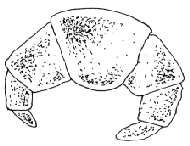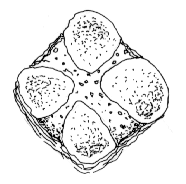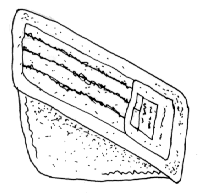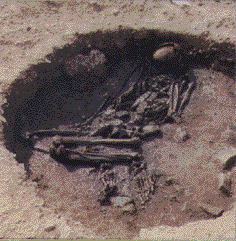Four Bread Things and a Funeral
Vicky Cooper spends a day filming with the crew of Meet the Ancestors, BBC2's long-awaited answer to the Time Team.
 7.00a.m. Sheffield train station. I am about to board a train that will speed me to Malmesbury Wiltshire, where filming is taking place for Meet the Ancestors, a series of five half hour programmes spanning the Bronze Age to Medieval periods, each dealing with one or two inhumations and placing them in a wider social context for the perusal of the viewer. The show is to be aired in January 1998, and is aimed at a midweek pre-watershed audience. So, is it worth missing Eastenders for, or will Tony Robinson retain his crown as prime interpretational suspect? I set out to investigate.
7.00a.m. Sheffield train station. I am about to board a train that will speed me to Malmesbury Wiltshire, where filming is taking place for Meet the Ancestors, a series of five half hour programmes spanning the Bronze Age to Medieval periods, each dealing with one or two inhumations and placing them in a wider social context for the perusal of the viewer. The show is to be aired in January 1998, and is aimed at a midweek pre-watershed audience. So, is it worth missing Eastenders for, or will Tony Robinson retain his crown as prime interpretational suspect? I set out to investigate.
It may have been the case that in the not too distant past, the abbey dominated the town of Malmesbury. However, the feature to visit this week is a 3x2 metre hole in the gardens of Abbey House. Created by an over-enthusiastic gardener, it contains a stone coffin of giant proportions. With rumours of seven feet tall men and talk of Athelstan himself, English Heritage called in the Meet the Ancestors team to record the excavation in progress and sort the big men from the slightly smaller ones.
11.00a.m. Malmesbury. When I joined the team on site, filming was already underway and while the presenter, Julian Richards, was busy treading the lawn in repetitive patterns tracked by the watchful eye of the camera lens, I took the opportunity to speak to the man excavating the burial, Jon Humble, a former Sheffield University graduate.

Julian Richards, presenter of the BBC's Meet the Ancestors
He could not deny that the excavation had been slowed down due to the presence of the cameras, but pointed out that as long as the excavation was not compromised in any way, he was happy for filming to go ahead. Jon suggests that it is unlikely that the stone coffin will be lifted from the ground, and the body itself may be reburied if the coroner decides after consultation that this is the right option. However, for the time being, our big man remains hidden from view.
 12.00 midday. The team pause for a moment's respite and a cheese and broccoli pasty. Two ladies turn up to view the remains. Digging is frequently interrupted by visits such as these, and combined with the demands of the television crew, there is much sitting around to be done. It is during one such interruption that I find myself one of very few active people on the site, scribbling furiously in editorial fervour failing to notice that the camera has turned its eye upon me. I freeze, hear the click of the camera being turned off and realise that my time for stardom has passed.
12.00 midday. The team pause for a moment's respite and a cheese and broccoli pasty. Two ladies turn up to view the remains. Digging is frequently interrupted by visits such as these, and combined with the demands of the television crew, there is much sitting around to be done. It is during one such interruption that I find myself one of very few active people on the site, scribbling furiously in editorial fervour failing to notice that the camera has turned its eye upon me. I freeze, hear the click of the camera being turned off and realise that my time for stardom has passed.
Meanwhile, Julian sighs and casts aside his jumper as the camera crew announce that they are ready to do a 'piece to camera', and makes sure that the three hats of archaeology, TV and public are firmly in place. Armed with trowels and smiles, Jon and Julian climb into the trench as we litter shovels, buckets and assorted archaeological paraphernalia around them to provide interest for the viewer. What I found more interesting were the items just out of shot, namely the row of mobile phones, each one waiting like an obedient dog for its master, a Snow White and the Seven Dwarves mug, and a plastic skull, apparently used in an open day earlier in the week. The pair snuggle in between the buckets and bags, and filming begins.......and then stops as an enormous party of some 30-40 German tourists arrive. Julian and Jon are relegated to a nearby bench.
I then have one of several surreal experiences of the day, in which a kind old German lady asks me a question in her native language, which, by some odd coincidence, I can speak. A conversation then follows about the coffin and the fact that she thinks it's empty. She can't see anything. I explain that the body is still under the earth. She replies, "Oh no dear, I don't think so but then I don't have my glasses. Isn't archaeology a peculiar profession for a girl?". I retire to the substitutes bench with the rest of the bewildered crew. The Germanic invasion vanishes almost as soon as it arrived and filming resumes. Julian is asked to do something very rare for an archaeologist, namely to 'go on a bit longer', which he obliges, and after six or seven more takes the film crew are happy and decamp to the abbey for the afternoon's filming.
My attention then turns to Ian Potts, one of the producers of the series, who, although not directly involved with the filming of this particular episode, is on hand to make sure all goes smoothly. He tells me that the programme is run on a budget of around �60,000 pounds per half hour, which is less than half of the cost of a single Channel Four Time Team programme. He also informs me that some costume dramas cost over �1m per episode, which prompted a much greater appreciation of Mr. Darcy than ever before. While the budget may seem meagre, it does manage to stretch to cartons of 'Just Juice' for everyone. Ian kindly provides one for me along with a......
 ...cheese and tomato roll for lunch, which is gratefully devoured. 1.30 p.m. The film crew have started to film inside the abbey, but I stay with the excavation until I finish my roll, which enables me to witness the arrival of rival journalists in the form of the local newspaper. I am pleased to observe that I am using the correct kind of notepad. The photographer is just about to take a snap of Jon in action when a nearby potted yew tree takes destiny into its own hands and plummets into the trench. Several sighs and minutes later, the photo is taken and the reporters vanish. It begins to rain, and I head off to the abbey, where Julian Richards is back in front of the lens.
...cheese and tomato roll for lunch, which is gratefully devoured. 1.30 p.m. The film crew have started to film inside the abbey, but I stay with the excavation until I finish my roll, which enables me to witness the arrival of rival journalists in the form of the local newspaper. I am pleased to observe that I am using the correct kind of notepad. The photographer is just about to take a snap of Jon in action when a nearby potted yew tree takes destiny into its own hands and plummets into the trench. Several sighs and minutes later, the photo is taken and the reporters vanish. It begins to rain, and I head off to the abbey, where Julian Richards is back in front of the lens.
Filming is taking place around a stone tomb, and the camera angle means that Julian has to start the take crouching down behind the sarcophagus to make sure he is out of shot. It is the camera team's job to avoid catching his transition to the vertical on film, and thus the ascent of man requires many takes. I finally get a quiet word with Julian, who tells me that he doesn't mind doing such a large amount of takes, as he obviously holds a great enthusiasm for the programme. He is interested in showing not just the process of excavation but also investigating why it is done. This certainly seems to have been the message I received in the filming I saw, and I believe that this series really will widen the boundaries of archaeology on television. This will not just be a programme about inhumation, it is very much more than that, dealing with all aspects of post-excavation and placing the individual in a broader context.
 8.00p.m. Speeding through the English countryside. Having left Malmesbury and the unresolved problem of the giant behind, I feel as if I have been a part of something very exciting, and I for one will be tuning in. After all, I need to know if the Malmesbury giant is finally cut down to size.
8.00p.m. Speeding through the English countryside. Having left Malmesbury and the unresolved problem of the giant behind, I feel as if I have been a part of something very exciting, and I for one will be tuning in. After all, I need to know if the Malmesbury giant is finally cut down to size.
The Malmesbury excavations will be the last in the Meet the Ancestors series. You can e-mail the Meet the Ancestors team at : [email protected] , who inform me that they are still keen to speak to anyone planning or running an excavation that may produce burials.
Taken from the BBC's Press Release:
"Meet the Ancestors!
Bringing history to life by excavating bodies from the ancient past.
An exciting glimpse into the past as 'Secrets of Lost Empires' archaeologist Julian Richards digs up and examines five bodies spanning over 300 years from the Bronze Age to Medieval times.
Our ancestors are all around us � part of the vast cemetery in which we all live. In past centuries our ancient dead helped shape and reinforce contemporary culture, but today they lie unclaimed in museum cases, artefacts rather than people. In a fast changing, multicultural society where few of us depend directly on the land, the link with our ancestors is broken.

A burial from the late Bronze age site at Bleadon, Nr Weston Super Mare, Somerset.
Five programmes of hands on, as it happens, archaeology gives some of our distant ancestors a chance to speak for themselves. In each programme, history is brought to life as a person is dug up and examined.
English Heritage archaeologist Julian Richards and a small team of experts will search for and excavate burials spanning over 3,000 years of our past from the Bronze Age in 2000BC to the Medieval period in around 1400AD.

Same burial from Bleadon, Nr Weston Super Mare, Somerset.
At each of the key stages, Julian Richards debates the evidence with on-site specialists as the full picture of who the bodies were gradually emerges. The series examines how each of our excavated ancestors lived and died and how their graves reflected the societies which buried them."
Return to Top
Acknowledgements
Many thanks go to Ian Potts, who kindly supplied the photographs, information and sandwiches, Ben Power for swift responses to our cries for help, Julian Richards and Jon Humble for patience beyond the call of duty, and everyone else who was at Malmesbury on 28/4/97.
� Vicky Cooper 1997
� assemblage 1997
 7.00a.m. Sheffield train station. I am about to board a train that will speed me to Malmesbury Wiltshire, where filming is taking place for Meet the Ancestors, a series of five half hour programmes spanning the Bronze Age to Medieval periods, each dealing with one or two inhumations and placing them in a wider social context for the perusal of the viewer. The show is to be aired in January 1998, and is aimed at a midweek pre-watershed audience. So, is it worth missing Eastenders for, or will Tony Robinson retain his crown as prime interpretational suspect? I set out to investigate.
7.00a.m. Sheffield train station. I am about to board a train that will speed me to Malmesbury Wiltshire, where filming is taking place for Meet the Ancestors, a series of five half hour programmes spanning the Bronze Age to Medieval periods, each dealing with one or two inhumations and placing them in a wider social context for the perusal of the viewer. The show is to be aired in January 1998, and is aimed at a midweek pre-watershed audience. So, is it worth missing Eastenders for, or will Tony Robinson retain his crown as prime interpretational suspect? I set out to investigate.
 12.00 midday. The team pause for a moment's respite and a cheese and broccoli pasty. Two ladies turn up to view the remains. Digging is frequently interrupted by visits such as these, and combined with the demands of the television crew, there is much sitting around to be done. It is during one such interruption that I find myself one of very few active people on the site, scribbling furiously in editorial fervour failing to notice that the camera has turned its eye upon me. I freeze, hear the click of the camera being turned off and realise that my time for stardom has passed.
12.00 midday. The team pause for a moment's respite and a cheese and broccoli pasty. Two ladies turn up to view the remains. Digging is frequently interrupted by visits such as these, and combined with the demands of the television crew, there is much sitting around to be done. It is during one such interruption that I find myself one of very few active people on the site, scribbling furiously in editorial fervour failing to notice that the camera has turned its eye upon me. I freeze, hear the click of the camera being turned off and realise that my time for stardom has passed. ...cheese and tomato roll for lunch, which is gratefully devoured. 1.30 p.m. The film crew have started to film inside the abbey, but I stay with the excavation until I finish my roll, which enables me to witness the arrival of rival journalists in the form of the local newspaper. I am pleased to observe that I am using the correct kind of notepad. The photographer is just about to take a snap of Jon in action when a nearby potted yew tree takes destiny into its own hands and plummets into the trench. Several sighs and minutes later, the photo is taken and the reporters vanish. It begins to rain, and I head off to the abbey, where Julian Richards is back in front of the lens.
...cheese and tomato roll for lunch, which is gratefully devoured. 1.30 p.m. The film crew have started to film inside the abbey, but I stay with the excavation until I finish my roll, which enables me to witness the arrival of rival journalists in the form of the local newspaper. I am pleased to observe that I am using the correct kind of notepad. The photographer is just about to take a snap of Jon in action when a nearby potted yew tree takes destiny into its own hands and plummets into the trench. Several sighs and minutes later, the photo is taken and the reporters vanish. It begins to rain, and I head off to the abbey, where Julian Richards is back in front of the lens. 8.00p.m. Speeding through the English countryside. Having left Malmesbury and the unresolved problem of the giant behind, I feel as if I have been a part of something very exciting, and I for one will be tuning in. After all, I need to know if the Malmesbury giant is finally cut down to size.
8.00p.m. Speeding through the English countryside. Having left Malmesbury and the unresolved problem of the giant behind, I feel as if I have been a part of something very exciting, and I for one will be tuning in. After all, I need to know if the Malmesbury giant is finally cut down to size.
